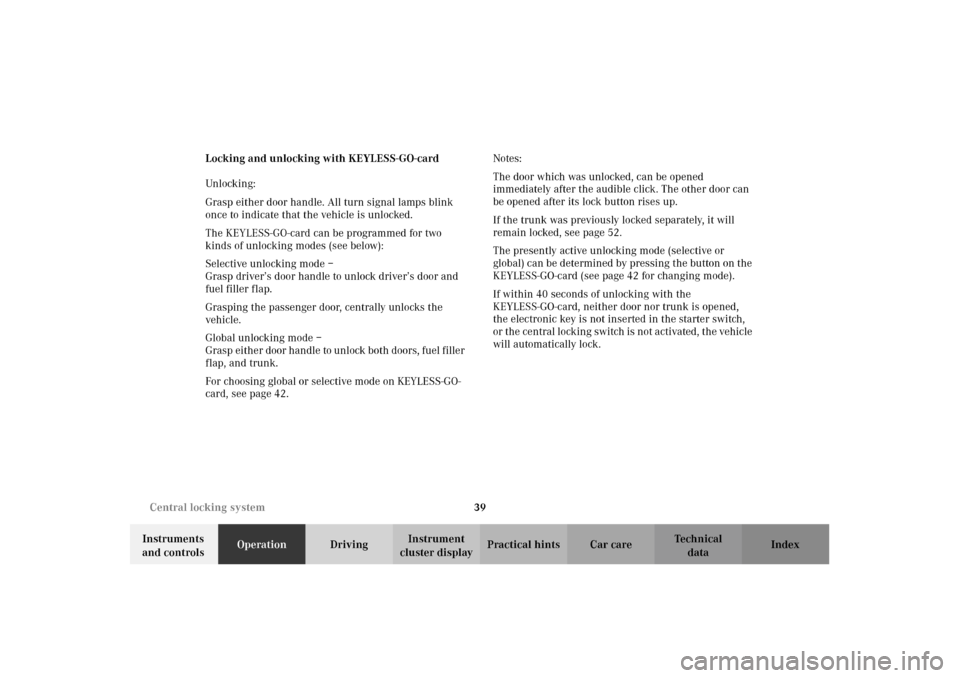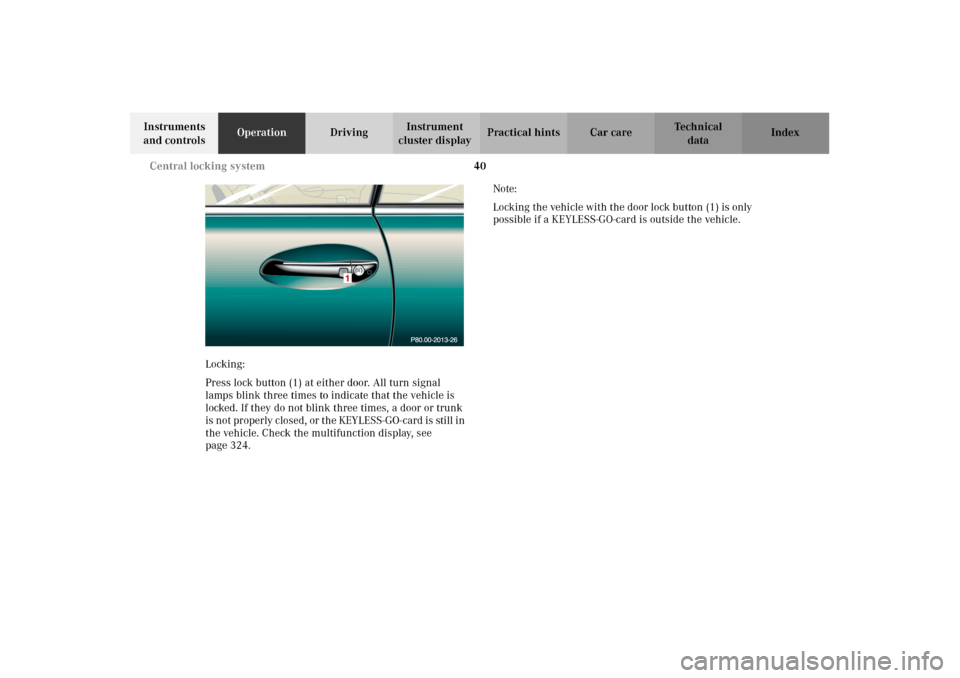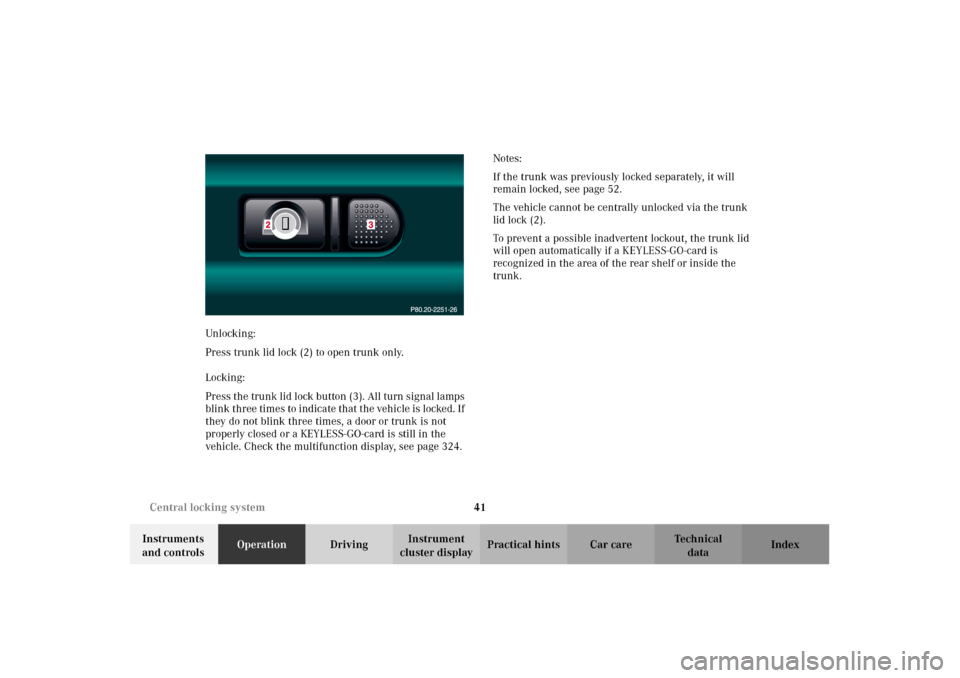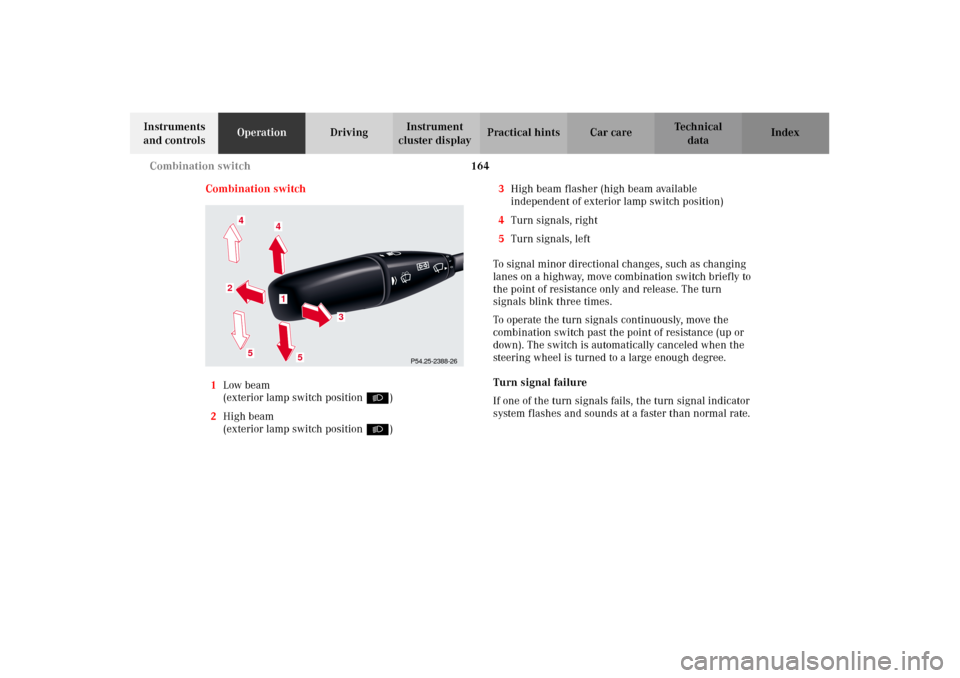2002 MERCEDES-BENZ CL600 turn signal
[x] Cancel search: turn signalPage 8 of 430

5 ContentsWindshield and headlamp
washer system ...........................340
Windshield and headlamp
washer fluid mixing ratio .........340
Spare wheel, vehicle tools, storage
compartment ............................. 341
Jack ...................................................342
Wheels .............................................343
Tire Replacement .......................343
Rotating wheels ..........................344
Spare wheel ....................................344
Changing wheels ...........................346
Tire inflation pressure .................. 351
Battery .............................................352
Jump starting ..................................355
Towing the vehicle .........................357
Exterior lamps ................................360
Headlamp assembly ................... 361
Taillamp assemblies ..................364
Standby bulb function ...................367Changing batteries
in the electronic key ................ 369
Synchronizing
remote control .............................371
Changing batteries in
the KEYLESS-GO-card ............. 372
Emergency engine shut-down ......374
Fuel filler flap,
manual release ..........................374
Emergency operation of
sliding/pop-up roof .................. 375
Replacing wiper blades .................376
Roof rack ......................................... 378
Vehicle careCleaning and care of
the vehicle ................................. 380
Power washer ............................. 381
Tar stains .................................... 382
Paintwork, painted body
components ................................ 382Engine cleaning ..........................382
Vehicle washing .........................382
Ornamental moldings ................383
Headlamps, taillamps,
turn signal lenses ......................383
Cleaning the Distronic
system sensor .............................384
Cleaning the parktronic
system sensors ...........................384
Wiper blades ...............................385
Light alloy wheels ......................386
Instrument cluster .....................387
Steering wheel and
gear selector lever ......................387
Cup holder ...................................387
Seat belts .....................................388
Headliner and shelf
below rear window .....................388
Leather upholstery .....................388
Hard plastic trim items .............388
Plastic and rubber parts ............388
J_OM_215.book Seite 5 Mittwoch, 30. Mai 2001 2:01 14
Page 38 of 430

35 Central locking system
Te ch n i c a l
data Instruments
and controlsOperationDrivingInstrument
cluster displayPractical hints Car care Index Locking and unlocking with remote control
Unlocking:
Press transmit buttonŒ. All turn signal lamps blink
once to indicate that the vehicle is unlocked.
The remote control can be programmed for two kinds of
unlocking modes (see below):
Selective unlocking mode –
Press transmit buttonŒ once to unlock driver’s door
and fuel filler flap.
Press transmit buttonΠtwice to unlock both doors,
fuel filler flap, and trunk.
Global unlocking mode –
Press transmit buttonΠonce to unlock both doors,
fuel filler flap, and trunk.
Notes:
If the trunk was previously locked separately, it will
remain locked, see page 52.
The presently active unlocking mode (selective or
global) can only be determined by unlocking the vehicle
with the remote control (see below for changing mode).If within 40 seconds of unlocking with the remote
control, neither door nor trunk is opened, the electronic
key is not inserted in the starter switch, or the central
locking switch is not activated, the vehicle will
automatically lock.
Locking:
Press transmit button‹ once. All turn signal lamps
blink three times to indicate that the vehicle is locked. If
they do not blink three times, a door or trunk is not
properly closed.
Note:
If the vehicle cannot be locked or unlocked by pressing
the transmit button, then it may be necessary to change
the batteries in the electronic key (if ok, battery check
lamp in electronic key will light briefly when pressing
transmit button) or to synchronize the remote control,
see pages 369 and 371.
J_OM_215.book Seite 35 Mittwoch, 30. Mai 2001 2:01 14
Page 42 of 430

39 Central locking system
Te ch n i c a l
data Instruments
and controlsOperationDrivingInstrument
cluster displayPractical hints Car care Index Locking and unlocking with KEYLESS-GO-card
Unlocking:
Grasp either door handle. All turn signal lamps blink
once to indicate that the vehicle is unlocked.
The KEYLESS-GO-card can be programmed for two
kinds of unlocking modes (see below):
Selective unlocking mode –
Grasp driver’s door handle to unlock driver’s door and
fuel filler flap.
Grasping the passenger door, centrally unlocks the
vehicle.
Global unlocking mode –
Grasp either door handle to unlock both doors, fuel filler
flap, and trunk.
For choosing global or selective mode on KEYLESS-GO-
card, see page 42.Notes:
The door which was unlocked, can be opened
immediately after the audible click. The other door can
be opened after its lock button rises up.
If the trunk was previously locked separately, it will
remain locked, see page 52.
The presently active unlocking mode (selective or
global) can be determined by pressing the button on the
KEYLESS-GO-card (see page 42 for changing mode).
If within 40 seconds of unlocking with the
KEYLESS-GO-card, neither door nor trunk is opened,
the electronic key is not inserted in the starter switch,
or the ce ntral lock in g s witch is n ot activated , t he vehic le
will automatically lock.
J_OM_215.book Seite 39 Mittwoch, 30. Mai 2001 2:01 14
Page 43 of 430

40 Central locking system
Te ch n i c a l
data Instruments
and controlsOperationDrivingInstrument
cluster displayPractical hints Car care Index
Locking:
Press lock button (1) at either door. All turn signal
lamps blink three times to indicate that the vehicle is
locked. If they do not blink three times, a door or trunk
is n ot pr oper ly c lo sed , or t he KEY LESS- GO - card is sti ll i n
the vehicle. Check the multifunction display, see
page 324.Note:
Locking the vehicle with the door lock button (1) is only
possible if a KEYLESS-GO-card is outside the vehicle.
J_OM_215.book Seite 40 Mittwoch, 30. Mai 2001 2:01 14
Page 44 of 430

41 Central locking system
Te ch n i c a l
data Instruments
and controlsOperationDrivingInstrument
cluster displayPractical hints Car care Index Unlocking:
Press trunk lid lock (2) to open trunk only.
Locking:
Press the trunk lid lock button (3). All turn signal lamps
blink three times to indicate that the vehicle is locked. If
they do not blink three times, a door or trunk is not
properly closed or a KEYLESS-GO-card is still in the
vehicle. Check the multifunction display, see page 324.Notes:
If the trunk was previously locked separately, it will
remain locked, see page 52.
The vehicle cannot be centrally unlocked via the trunk
lid lock (2).
To prevent a possible inadvertent lockout, the trunk lid
will open automatically if a KEYLESS-GO-card is
recognized in the area of the rear shelf or inside the
trunk.
J_OM_215.book Seite 41 Mittwoch, 30. Mai 2001 2:01 14
Page 118 of 430

115 Instrument cluster
Te ch n i c a l
data Instruments
and controlsOperationDrivingInstrument
cluster displayPractical hints Car care Index 1Knob for instrument cluster illumination,
seepage116
2Engine malfunction indicator lamp, see page 296
3Brake fluid low or parking brake engaged,
seepage307
4Supplemental restraint system (SRS) malfunction
indicator lamp, see page 299
5Coolant temperature gauge, see page 117
6Outside temperature indicator, see page 117
7Fuel gauge with reserve warning lamp, see page 299
8Left turn signal indicator lamp, see combination
switch on page 164
9Speedometer, see page 118
10Electronic stability program (ESP) warning lamp,
system is adjusting to road conditions, see page 301
11Distance warning lamp – vehicles with Distronic
(DTR), distance to the vehicle ahead is insufficient,
see page 270 and page 301.
Vehicles without Distronic: It illuminates with the
electronic key in starter switch position 2. It should
go out when the engine is running.12Multifunction display, see page 120
Malfunction and warning messages in the
multifunction display, see page 303
13Trip odometer, see page 119 and 124
14Main odometer, see page 124
15Right turn signal indicator lamp, see combination
switch on page 164
16Tachometer, see page 119
17Gear range indicator display, see selector lever
positions on page 238
18Digital clock
To set the time, see COMAND operator’s manual
19Antilock brake system (ABS) malfunction indicator
lamp, see page 300
20High beam headlamp indicator,
see exterior lamp switch, page 159, and
combination switch, page 164
21Fasten seat belts, see page 302
22Reset buttonJ, s e e p a g e s 116 , 119
J_OM_215.book Seite 115 Mittwoch, 30. Mai 2001 2:01 14
Page 153 of 430

150 Flexible service system
Te ch n i c a l
data Instruments
and controlsOperationDrivingInstrument
cluster displayPractical hints Car care Index
Flexible service system (FSS)
(service indicator)
The FSS permits a flexible service schedule that is
directly related to the operating conditions of the
vehicle.
The symbol9 or½ appears together with a
message in the multifunction indicator prior to the next
suggested service. Depending on operating conditions
throughout the year, the next service is calculated and
displayed in days or distance remaining.The message is displayed for approximately 10 seconds
when turning the electronic key in starter switch to
position 2, or while driving when reaching the service
warning threshold.
The symbols and messages indicate the type of service
to be performed:
9Service A
½Service B
One of the following messages will appear in the display
(e.g. Service A):
“SERVICE A – IN xx DAYS”
“SERVICE A – IN xx MILES” (Canada: KM)
“SERVICE A – EXCEEDED BY xx DAYS”
“SERVICE A – EXCEEDED BY xx MILES” (Canada: KM)
“SERVICE A – PERFORM SERVICE”
The next service due date is displayed either in days or
in miles, depending on your driving style.
Once the suggested service term has passed, the symbol
and message appear for approximately 30 seconds and
a signal sounds every time when turning the electronic
key in starter switch to position 2.
P54.30-2768-26
J_OM_215.book Seite 150 Mittwoch, 30. Mai 2001 2:01 14
Page 167 of 430

164 Combination switch
Te ch n i c a l
data Instruments
and controlsOperationDrivingInstrument
cluster displayPractical hints Car care Index
Combination switch
1Low beam
(exterior lamp switch positionB)
2High beam
(exterior lamp switch positionB)3High beam flasher (high beam available
independent of exterior lamp switch position)
4Turn signals, right
5Turn signals, left
To signal minor directional changes, such as changing
lanes on a highway, move combination switch briefly to
the point of resistance only and release. The turn
signals blink three times.
To operate the turn signals continuously, move the
combination switch past the point of resistance (up or
down). The switch is automatically canceled when the
steering wheel is turned to a large enough degree.
Turn signal failure
If one of the turn signals fails, the turn signal indicator
system flashes and sounds at a faster than normal rate.
P54.25-2388-26
5
2
1
4
3
4
5
J_OM_215.book Seite 164 Mittwoch, 30. Mai 2001 2:01 14